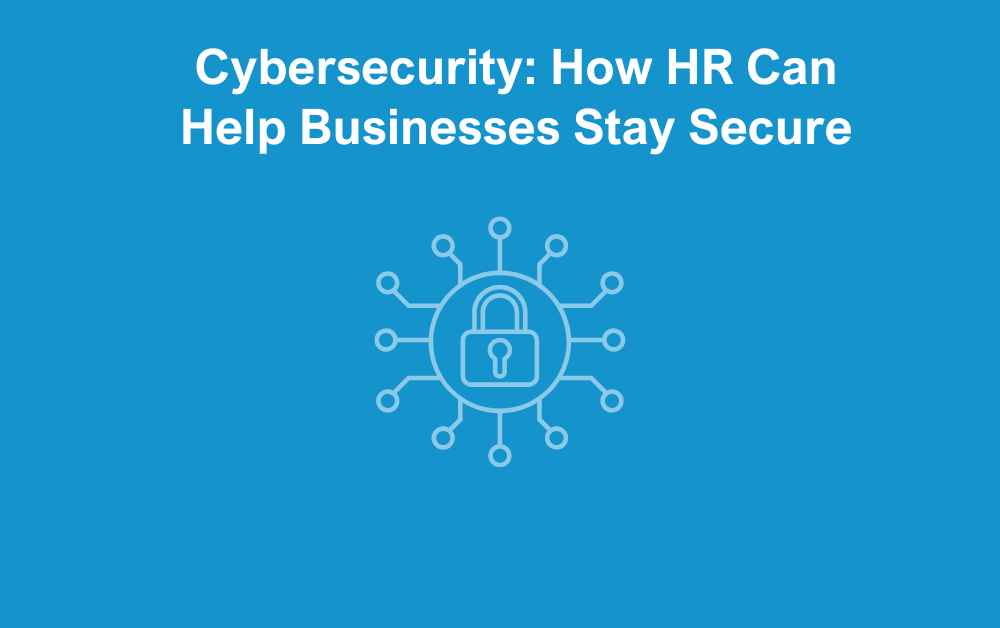In today’s interconnected world, the importance of robust cybersecurity cannot be overstated. Protecting your business against digital threats is not just a matter of securing data; it’s about safeguarding your reputation, customer trust, and bottom line. But this isn’t just an IT concern—HR plays a crucial role in fostering a security-first culture within an organisation.
Here’s how HR can help businesses stay on top of cyber security and improve overall security measures.
Assess Vulnerabilities
A strong strategy starts with a comprehensive assessment. HR can support this process by ensuring that employees are aware of security risks and that cybersecurity audits include a focus on human factors, such as phishing susceptibility and social engineering threats.
HR can also work with IT teams to establish protocols for background checks on employees handling sensitive information. Ensuring that access is only granted to trustworthy personnel reduces insider threats.
If your organisation lacks a dedicated IT expert to perform vulnerability assessments, consider outsourcing to a specialist to conduct an in-depth audit.
Develop a Cybersecurity Policy
Craft a cybersecurity policy that clearly outlines your organisation’s approach to security. It’s also important to define roles and responsibilities, establish guidelines for data handling, and set clear expectations for incident reporting and response.
These policies typically cover a wide range of topics, including:
- Access control
- Password management
- Data encryption
- Incident response
- Employee training.
Additionally, they may also incorporate legal and regulatory compliance requirements specific to the industry in which the business operates.
Having this type of policy is of paramount importance in today’s digital landscape for several reasons. Firstly, it helps you identify and prioritise potential risks and vulnerabilities, enabling you to proactively address cybersecurity issues before they escalate into major breaches. Secondly, it provides clear guidelines to employees and stakeholders on how to handle sensitive information and use digital resources securely, reducing the likelihood of human errors or negligence leading to security incidents.
Furthermore, a well-defined policy can enhance an organisation’s reputation and credibility by demonstrating a commitment to data protection and compliance with relevant laws and regulations. Ultimately, it serves as a crucial tool in mitigating cyber threats.
If you would like help to create a Cybersecurity policy, our HR experts are more than happy to help you with this.
Train Your Team
Employees are the first line of defence against cyber threats. HR can implement regular management training programmes to educate staff on:
- Recognising phishing emails and social engineering tactics
- Best practices for password management and multi-factor authentication (MFA)
- Safe handling of sensitive company and customer data
- Incident reporting procedures
HR should ensure cybersecurity training is part of the onboarding process and continuously reinforced through refresher sessions, phishing simulations, and internal communications. By embedding cybersecurity awareness into company culture, businesses can significantly reduce the risk of human error leading to security breaches.
Access Control
Effective cyber access control methods are essential for mitigating breaches by ensuring that only authorised individuals or systems can access sensitive information and resources. Here are some key access control methods that can help enhance cybersecurity:
- Role-Based Access Control (RBAC): RBAC assigns permissions and access rights based on an individual’s job role within the organisation. This method limits access to only what is necessary for an employee to perform their job, reducing the risk of unauthorised access to critical systems and data.
- Two-Factor Authentication (2FA) and Multi-Factor Authentication (MFA): 2FA and MFA require users to provide two or more forms of authentication, such as a password and a fingerprint or a security token, before granting access. This additional layer of security makes it much harder for unauthorised users to gain access, even if they have the correct password.
- Strong Password Policies: Enforcing strong password policies as part of cybersecurity efforts, including requirements for long and complex passwords, regular password changes, and password storage best practices, can help prevent unauthorised access through brute force or password guessing attacks.
- Access Reviews and Auditing: Regularly reviewing and auditing user access permissions and activity logs can help identify and rectify any suspicious access promptly.
- Zero Trust Security Model: The Zero Trust model assumes that no user or device can be trusted by default, regardless of their location within or outside the network. It enforces strict access controls, continuous monitoring, and verification for all users and devices, reducing the attack surface and mitigating breaches.
Promote Regular Software Updates
HR can help reinforce the importance of timely software updates and Cybersecurity patches by communicating policies that encourage:
- Employees to update their devices and applications regularly.
- IT teams to roll out updates and patches efficiently.
- A culture of responsibility where employees understand the risks of using outdated software.
Implement Encryption and Secure Data Handling
Data security is essential for any business. HR should ensure that employees adhere to encryption protocols when handling sensitive data, both in transit and at rest. Training employees on secure file-sharing methods and proper data disposal is vital in preventing accidental leaks.
Encourage Backup and Recovery Practices
HR can work with IT teams to educate employees on the importance of regular backups. This includes:
- Ensuring critical business data is backed up securely and regularly.
- Training employees on proper data recovery procedures in case of an incident.
- Promoting a proactive approach to disaster recovery planning.
Foster a Security-Conscious Culture
A company’s cybersecurity posture is only as strong as its employees’ awareness and commitment. HR should:
- Incorporate cybersecurity into company values and policies.
- Recognise and reward employees who follow best security practices.
- Encourage employees to report suspicious activities without fear of repercussions.
Partner with Cybersecurity Experts
HR can facilitate partnerships with external cybersecurity consultants or Managed Security Service Providers (MSSPs) to strengthen defences. Outsourcing expertise can provide ongoing security monitoring, penetration testing, and compliance support.
Ensure Incident Response Preparedness
HR plays a pivotal role in ensuring that employees are prepared for cyber incidents. This includes:
- Conducting regular cybersecurity drills and tabletop exercises.
- Ensuring that employees understand how to report security breaches quickly.
- Establishing clear communication channels for incident response coordination.
Stay on Top of Emerging Threats
Cyber threats are constantly evolving. HR should work alongside IT to stay updated on emerging risks and adapt policies and training accordingly. Participating in industry cybersecurity forums and collaborating with cybersecurity professionals can help businesses stay ahead of new threats.
Educate Customers and Build Trust
Beyond internal security, businesses must also ensure that customers are educated on best practices when interacting with their services online. HR can support marketing and customer service teams in creating educational content on:
- Recognising scams and fraudulent communications.
- Setting up secure passwords and enabling MFA.
- Safe online transaction practices.
By promoting cybersecurity awareness externally, businesses can enhance customer trust and reduce the likelihood of fraud-related issues.
Contact Us
By taking a proactive role in cybersecurity, HR can help businesses build a resilient security culture, protect sensitive information, and ensure compliance with evolving regulations. If you need assistance in developing a cybersecurity policy or implementing effective training programmes, contact our HR experts today.







